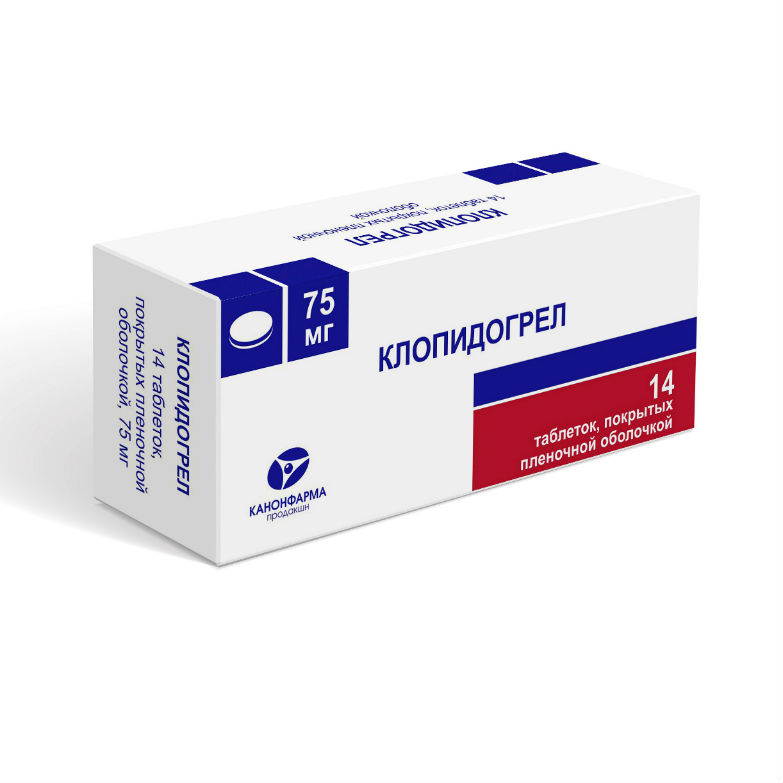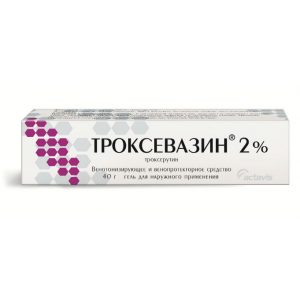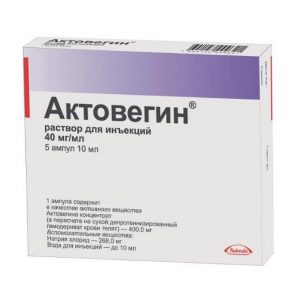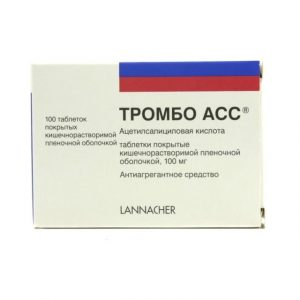Description
Release form
Film-coated tablets.
packaging 14 pcs
Pharmacological action of
Clopidogrel, a specific and active inhibitor of platelet aggregation, has a coronary dilating effect. Selectively reduces the binding of ADP to platelet receptors and activation of GPI Ib / IIIa receptors by ADP. weakening platelet aggregation. Reduces platelet aggregation caused by other agonists, preventing their activation by released ADP, does not affect the activity of phosphodiesterase (PDE). Irreversibly binds to platelet ADP receptors, which remain immune to ADP stimulation throughout the life cycle (about 7 days). Inhibition of platelet aggregation is observed 2 hours after ingestion (40% inhibition) of an initial dose of 400 mg. The maximum effect (60% inhibition of aggregation) develops after 4 7 days of continuous administration of a dose of 50 100 mg / day. The antiplatelet effect lasts the entire period of platelet life (7-10 days). In the presence of atherosclerotic lesions of the vessel, it prevents the development of atherothrombosis regardless of the localization of the vascular process (cerebrovascular, cardiovascular or peripheral lesions).
Indications
Prevention of thrombotic complications: after myocardial infarction (from several days to 35 days), ischemic stroke (from 6 days to 6 months) or diagnosed with peripheral artery disease
in acute coronary syndrome without ST segment elevation (unstable angina or myocardial infarction without pathological Q wave), including patients undergoing percutaneous coronary artery bypass surgery, in combination with with
acetylsalicylic acid in acute coronary syndrome with ST segment elevation (acute myocardial infarction) in combination with acetylsalicylic acid in patients receiving drug treatment with the possible use of thrombolytic therapy.
Contraindications
severe liver failure
acute bleeding (e.g. with peptic ulcer or intracranial hemorrhage)
pregnancy
breastfeeding period
age up to 18 years (safety and efficacy have not been established)
hypersensitivity to the drug components. Caution should be given to the drug for liver and kidney diseases (including moderate hepatic and / or renal failure), injuries, preoperative conditions.
Special instructions
During the treatment period, it is necessary to monitor the hemostasis system parameters (activated partial thromboplastin time (APTT), platelet count, platelet functional activity tests), regularly examine the functional activity of the liver.
Clopidogrel should be used with caution in patients at risk of severe bleeding from trauma, surgical intervention of patients receiving acetylsalicylic acid, non-steroidal anti-inflammatory drugs (including COX-2 inhibitors), heparin, or IIb / IIIa glycoprotein inhibitors. Careful monitoring of patients is necessary to detect any signs of bleeding, including hidden, especially during the first weeks of using the drug and / or after invasive heart procedures or surgeries. With planned surgical interventions, treatment with clopidogrel should be discontinued 7 days before surgery.
Patients should be warned that stopping the bleeding will take longer than usual, so they should inform the doctor about each case of bleeding.
Rare cases of thrombotic thrombocytopenic purpura (TTP) after clopidogrel have been reported. This condition was characterized by thrombocytopenia and microangiopathic hemolytic anemia in combination with neurological symptoms, impaired renal function, or fever. The development of TTP poses a threat to life and requires urgent measures, including plasmapheresis. Due to insufficient data, clopidogrel should not be prescribed in the acute period of ischemic stroke (in the first 7 days). The drug should be prescribed with caution in patients with impaired renal function.
Clopidogrel should be used with caution in patients with moderate hepatic impairment in whom hemorrhagic diathesis may occur.
In patients with congenital galactose intolerance, glucose-galactase malabsorption syndrome and lactase deficiency should not take clopidogrel.
Composition
1 tablet contains clopidogrel hydrosulfate 97.875 mg, in terms of clopidogrel – 75 mg
excipients: pregelatinized starch. anhydrous lactose (anhydrous milk sugar), macrogol (polyethylene glycol 6000). magnesium stearate. microcrystalline cellulose (PH 112), castor oil hydrogenated film coating composition: Selecout AQ-01673 (hypromellose (hydroxypropyl methylcellulose), macrogol (polyethylene glycol 400), macrogol (polyethylene glycol 6000), titanium dioxide, aluminum varnish based on Ponso 4 R dye).
Dosage and Administration
Clopidogrel is taken orally, regardless of food intake.
For the prevention of ischemic disorders in patients after myocardial infarction, ischemic stroke and diagnosed peripheral artery disease – 75 mg 1 time / day. Treatment should begin in the period from a few days to 35 days after myocardial infarction and from 7 days to 6 months after an ischemic stroke.
In acute coronary syndrome without ST-segment elevation (unstable angina or myocardial infarction without Q wave), treatment should be started with a single loading dose of 300 mg, and then continue to use the drug at a dose of 75 mg 1 time / day (with the simultaneous administration of acetylsalicylic acid in dose of 75-325 mg / day). Since the use of acetylsalicylic acid in high doses is associated with a high risk of bleeding, the recommended dose should not be higher than 100 mg. The course of treatment is up to 1 year.
In acute myocardial infarction with ST segment elevation, the drug is prescribed at a dose of 75 mg 1 time / day using the initial loading dose in combination with acetylsalicylic acid with or without thrombolytics. For patients over the age of 75 years, treatment with clopidogrel should be carried out without the use of a loading dose. Combination therapy is started as soon as possible after the onset of symptoms and continues for at least 4 weeks.
Side effects
Frequency: very often – more than 1/10, often more than 1/100 and less than 1/10, infrequently more than 1/1000 and less than 1/100, rarely – more than 1/10000 and less than 1/1000 , very rarely – less than 1/10000, including isolated cases.
From the hemopoietic organs: infrequently – thrombocytopenia, leukopenia, eosinophilia rarely – neutropepia, incl. very rare – thrombotic thrombocytopenic purpura, anemia incl. aplastic, pancytopenia, agranulocytosis, severe thrombocytopenia, granulocytopenia.
Allergic reactions: very rarely – anaphylactic reactions, serum sickness.
From the nervous system: infrequently – headache, dizziness, paresthesia, intracranial bleeding, including with a fatal outcome is very rare – confusion, hallucinations, taste disturbance.
From the sensory organs: infrequently – conjunctival hemorrhage, eyes, retina rarely – vertigo.
From the CCC side: often – a hematoma is very rare – heavy bleeding, bleeding from an operating wound, vasculitis, decreased blood pressure.
From the respiratory system: very often – nosebleeds are very rare – bronchospasm, interstitial pneumonitis, pulmonary hemorrhage, hemoptysis.
From the digestive system: often – diarrhea, abdominal pain, dyspepsia, bleeding from the gastrointestinal tract infrequently – stomach ulcer and 12 duodenal ulcer, gastritis, vomiting, nausea, constipation, flatulence rarely – retroperitoneal bleeding very rarely – pancreatitis, colitis, including ulcerative or lymphocytic, stomatitis, acute liver failure, hepatitis, impaired liver function tests, gastrointestinal bleeding with a fatal outcome.
From the skin: often – subcutaneous hemorrhage infrequently – skin rash, itching, purpura very rarely – angioedema, urticaria, erythematous rash, erythema multiforme, Stevens-Johnson syndrome, toxic epidermal necrolysis, eczema, lichen planus.
From the musculoskeletal system: very rarely – hemarthrosis, arthritis, arthralgia, myalgia.
From the genitourinary system: infrequently – hematuria is very rare – glomerulonephritis, hypercreatininemia.
Local reactions: often – bleeding at the injection site.
Laboratory readings: infrequently – prolonged bleeding time.
Other: very rare – fever.
Drug interaction
The combined use of clopidogrel with warfarin is not recommended, since such a combination can increase the intensity of bleeding.
Prescribing glycoprotein IIb / IIIa inhibitors together with clopidogrel increases the risk of bleeding.
The use of non-steroidal anti-inflammatory drugs in conjunction with clopidogrel increases the risk of bleeding.
Concomitant use of clopidogrel with CYP2C19 inhibitors (e.g. omeprazole) is not recommended.
No clinically significant pharmacodynamic interaction was observed with clopidogrel combined with atenolol, nifedipine, phenobarbital, cimetidine, estrogen, digoxin, theophylline, tolbutamide, antacids.
Overdose
Symptoms: prolonged bleeding time and subsequent complications.
Treatment: If bleeding occurs, appropriate therapy should be performed. If rapid correction of prolonged bleeding time is required, platelet transfusion is recommended. There is no specific antidote.
Storage conditions
Do not store above 25 ° C. Keep out of the reach and sight of children.
Shelf life
2 years.
Deystvuyushtee substance
Clopidogrel
dosage form
tablets
Appointment
Appointment
Adults doctor’s prescription




